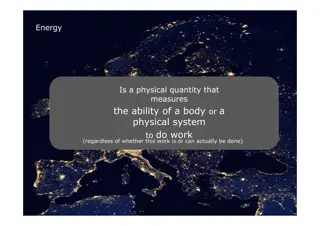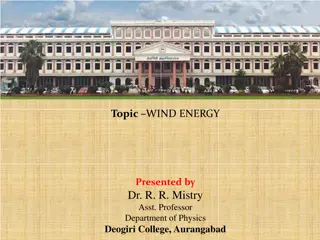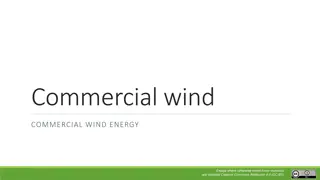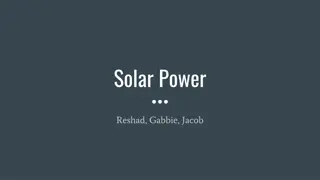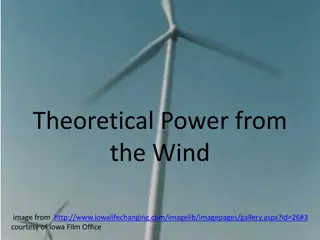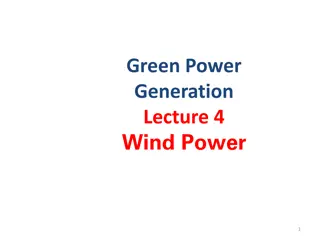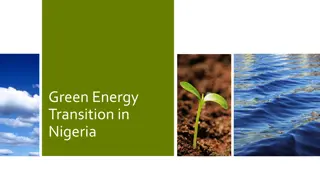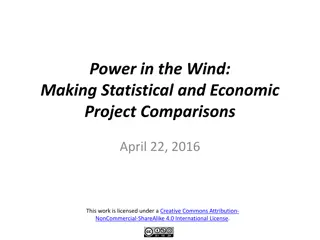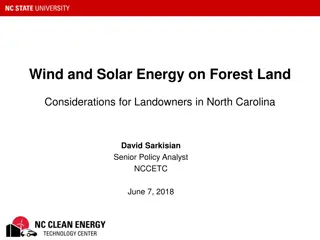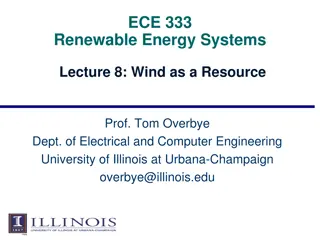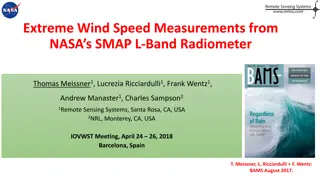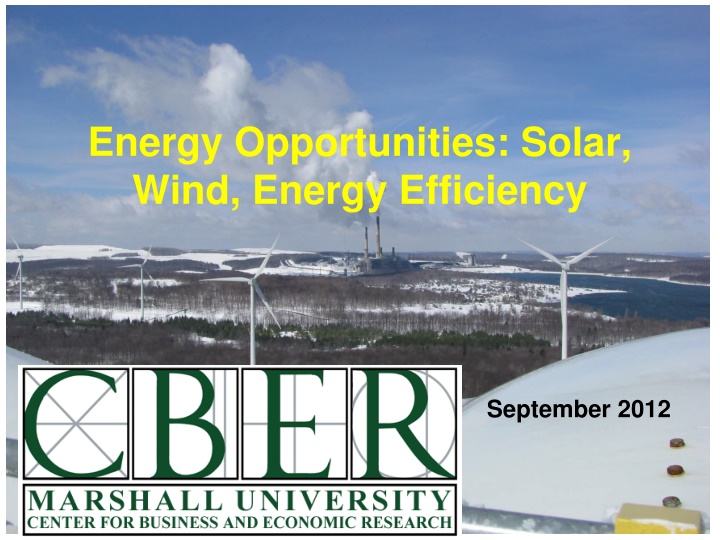
Energy Opportunities: Solar, Wind, Energy Efficiency September 2012
This content provides insights into solar and wind energy opportunities, electricity generation by non-hydro renewable resources, installed solar capacity, solar insolation data, and policy recommendations for solar and wind energy in the U.S. It also includes details on the installed wind capacity and generation in regional states as of 2011.
Download Presentation

Please find below an Image/Link to download the presentation.
The content on the website is provided AS IS for your information and personal use only. It may not be sold, licensed, or shared on other websites without obtaining consent from the author. If you encounter any issues during the download, it is possible that the publisher has removed the file from their server.
You are allowed to download the files provided on this website for personal or commercial use, subject to the condition that they are used lawfully. All files are the property of their respective owners.
The content on the website is provided AS IS for your information and personal use only. It may not be sold, licensed, or shared on other websites without obtaining consent from the author.
E N D
Presentation Transcript
Energy Opportunities: Solar, Wind, Energy Efficiency September 2012
U.S. Electricity Generation by Non-Hydro Renewable Resources (billion kWh)
Approximate Installed Solar Capacity (MW)
Average Annual Solar Insolation, Selected Cities kWh/m2 /Day 6.51 kWh/m2 /day 4.75 Area Area Daggett, CA Philadelphia, PA Las Vegas, NV Flagstaff, AZ Austin, TX Atlanta, GA 6.31 5.91 5.24 5.03 Charleston, WV Cleveland, OH Boston, MA Seattle, WA 4.55 4.31 4.23 3.67 SOURCE: PV Watts (2012). WV s insolation is ranked the 8th lowest out of 50 states.
Solar Conclusions Solar energy is a moderate resource in WV Solar does not contribute as much economically due to little manufacturing and low operating costs. Primary economic benefits come from applicable taxes, the removal of which are common incentives. Funding solar through utility rates obscures the real price of avoided electricity purchases. SREC markets assign the role of market maker to State Legislatures. Unresolved grid integration issues reduce the ability to offset fossil resources. Beyond 5 years, grid integration solutions will be more widespread allowing more benefit.
Solar Policy Recommendations 1. Maintain current policies. The current policy is likely to induce some interested WV residents to adopt solar PV technology, but not at very high levels. 2. Monitor the results of research being conducted on the options to efficiently integrate wind and solar resources into the grid. Applicable State Organizations: Division of Energy, Public Service Commission.
Installed Wind Capacity and Generation in Regional States, as of 2011 State Rank in 2011 37th 4th 13th 28th 36th 12th 29th 15th 20th % of In-State MWh in 2010 0.05% 2.21% 2.34% 0.00% 0.02% 1.90% 0.01% 0.81% 1.16% % of In-State MWh in 2011 0.04%* 3.15% 2.72% 0.76% 0.02% 2.06% 0.13% 0.86% 1.39% Installed Capacity State Delaware Illinois Indiana Maryland New Jersey New York Ohio Pennsylvania West Virginia 610 MW 2 MW 2.7 GW 1.3 GW 120 MW 7.5 MW 1.4 GW 112 MW 789 MW Sources: (Wind Powering America 2012), (AWEA 2012) and (EIA 2012). * Data not published. Percentage is based on the same output as in 2010.
Wind Conclusions The quantity of wind estimated to be developable on private land may be less than what is developed or under consideration. Lease payments and property taxes are the biggest economic impact of wind. Turbine maintenance services also. Manufacturing is minimal. Siting of wind facilities is very difficult, but almost the same as for other power plants. Unresolved efficiency issues related to grid integration of wind energy need to be understood more in terms of accomplishing policy objectives. The extension of the federal PTC will determine future development efforts.
Wind Policy Recommendations 1. Maintain current policies. The two existing State tax incentives are a balanced acknowledgement of public and private interests. 2. Monitor the results of research being conducted on the options to efficiently integrate wind and solar resources into the grid. Applicable State Organizations: Division of Energy, Public Service Commission.
Energy Efficiency Overview Where is the State in efficiency efforts? First Energy - $2 million program Appalachian Power - $6 million program Adoption of recent industry standards for construction of State buildings Building code training by WVDOE Federal programs Industries of the Future, Industrial Assessment Centers, low-income weatherization assistance
Household Energy Consumption, Appalachian States Sources: U.S. EIA, U.S. Census Bureau s American Community Survey 2009 and 2010 Census
Population Density, Appalachian States Sources: U.S. EIA, U.S. Census Bureau s American Community Survey 2009 and 2010 Census
Benefits of Energy Efficiency More efficient use of resources (getting more with less) Can reduce impacts of increasing electricity rates Can contribute to a decrease in peak power demand due to the decrease in overall demand Can put off the need to build more power plants and T&D lines (and associated costs) Local job creation
EE Policy Recommendations State-Related: 1. Statewide adoption of the 2009 IECC and 2007 ASHRAE standards 2. Keep the State no further than one series of codes behind the most recent version 3. Appointment of an Energy Efficiency Ad-hoc position to the State Fire Commission 4. Conduct a study to evaluate the feasibility of making the energy code portion of the State Building Code enforceable statewide. 5. Continue support of WVDOE EE-related programs
EE Policy Recommendations Utility-Related: 1. Establish an Energy Efficiency Resource Standard with targeted goals for producing energy savings via EE programs. 2. Implement decoupling or a similar mechanism to allow for reasonable recovery of utilities lost revenues resulting from State-mandated EE programs. 3. Establish a stakeholder working group to provide guidance on EE program elements such as program evaluation, level of resource standards, potential program expansion and decoupling provisions.



